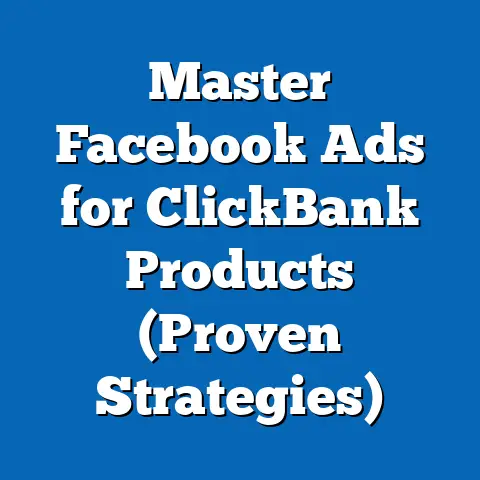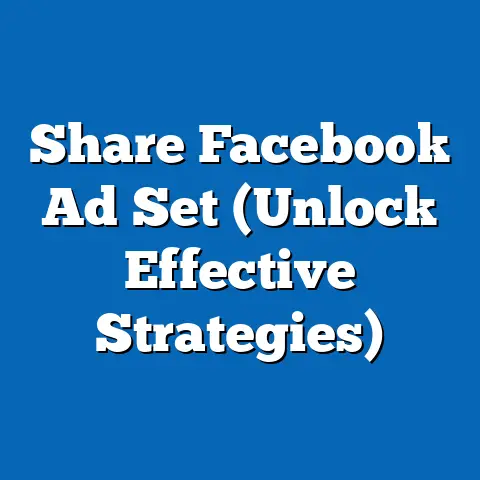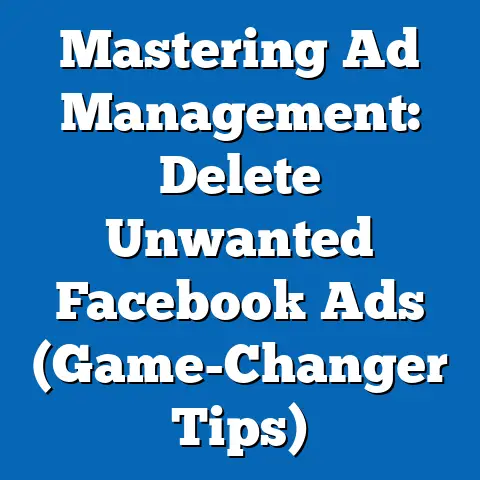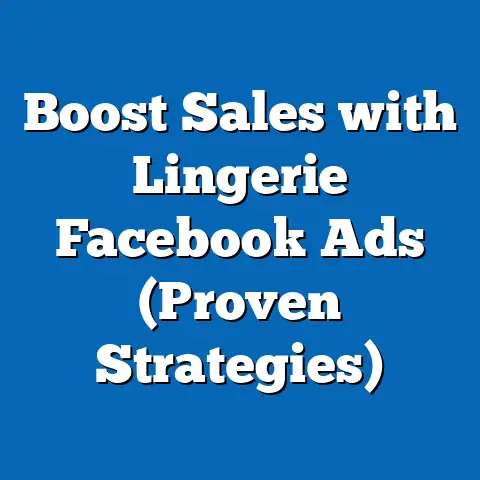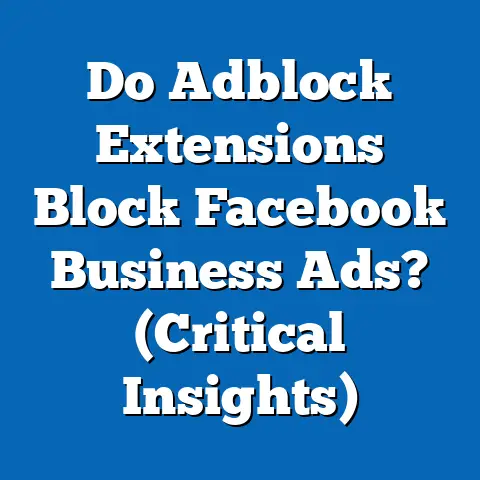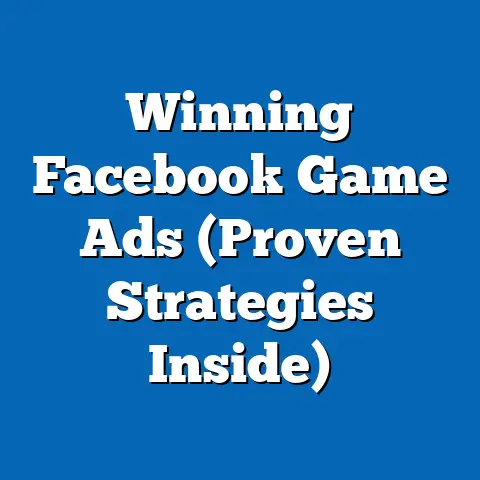Master Facebook Ads Start (Proven Strategies Unveiled)
Facebook advertising. It’s a term that can either excite you with the promise of reaching billions or fill you with dread at the thought of another wasted ad spend. I get it. I’ve been there. I remember the early days of Facebook ads – simpler times, perhaps, but far less sophisticated than what we have now. Back then, it felt like throwing spaghetti at the wall and hoping something stuck. Now, it’s a complex, data-driven art form.
Today, Facebook isn’t just a social network; it’s an advertising behemoth. According to Statista, Facebook’s advertising revenue reached a staggering $116.6 billion in 2022, showcasing its immense power and reach. But with great power comes great complexity. The platform is constantly evolving, with new features, algorithms, and best practices emerging all the time. That’s why mastering Facebook ads requires a continuous learning and adaptation process.
Understanding the Evolution of Facebook Ads
To truly master Facebook ads, it’s essential to understand where it all began. The journey of Facebook advertising is a fascinating one, filled with pivotal moments that have shaped the platform we know today.
I remember when Facebook first introduced advertising in 2004 with “Flyers.” These were simple, text-based ads displayed on the right-hand side of the page. They were basic, but they marked the beginning of a new era in digital marketing. It was a far cry from the sophisticated targeting and creative options we have now, but it was a start.
The real turning point came in 2007 with the introduction of Facebook Ads Manager. This platform revolutionized the way businesses could advertise on Facebook, offering more sophisticated targeting options based on demographics, interests, and behaviors. This allowed advertisers to reach specific audiences with tailored messages, leading to higher engagement and conversion rates.
Over the years, Facebook continued to innovate, introducing new ad formats like video ads, carousel ads, and collection ads. Each of these formats offered unique ways to engage with users and tell compelling brand stories. I’ve personally seen the impact of these new formats – video ads, in particular, have become a powerhouse for driving brand awareness and generating leads.
Another significant milestone was the acquisition of Instagram in 2012. This opened up a whole new world of advertising opportunities, allowing businesses to reach a younger, more visually oriented audience. Integrating Instagram ads into the Facebook Ads Manager made it easier than ever to run cross-platform campaigns and maximize reach.
However, the evolution of Facebook ads hasn’t been without its challenges. In recent years, privacy concerns and regulatory changes like GDPR and CCPA have forced Facebook to adapt its advertising practices. This has led to increased transparency and control for users, but it has also made it more challenging for advertisers to target audiences effectively.
Despite these challenges, Facebook has continued to evolve, introducing new tools and technologies like machine learning and artificial intelligence to help advertisers optimize their campaigns and achieve their goals. The platform has also invested heavily in improving ad relevance and user experience, ensuring that ads are not only effective but also engaging and non-intrusive.
Takeaway: Understanding the history of Facebook ads provides valuable context for the strategies we use today. The platform has evolved dramatically, and staying up-to-date with the latest changes is crucial for success.
Current Trends in Facebook Advertising
The world of Facebook advertising is constantly changing, and it’s crucial to stay ahead of the curve to maximize your results. In 2023, several key trends are shaping the landscape, and understanding these trends is essential for crafting effective campaigns.
One of the most significant trends is the rise of video content and short-form ads. Video has become the dominant form of media on social platforms, and Facebook is no exception. Short-form videos, in particular, are gaining traction due to their ability to capture attention quickly and deliver concise messages. Think Reels and Stories ads – these are prime real estate for engaging your audience with visually compelling content.
I remember when I first started experimenting with video ads. Initially, I was hesitant, thinking it would be too expensive and time-consuming to produce high-quality videos. But I quickly realized that you don’t need a Hollywood production to create effective video ads. Even simple, authentic videos shot on your smartphone can resonate with your audience and drive results.
Another key trend is the increasing importance of personalization and targeted advertising. Users are bombarded with ads every day, so it’s more important than ever to deliver messages that are relevant and engaging. Facebook’s sophisticated targeting options allow you to reach specific audiences based on demographics, interests, behaviors, and even custom audiences created from your own customer data.
I’ve found that personalized ads consistently outperform generic ads. By tailoring your message to the specific needs and interests of your target audience, you can increase engagement, conversion rates, and overall ROI. For example, if you’re selling fitness products, you could create separate ad campaigns targeting different segments of your audience, such as beginners, intermediate athletes, and advanced bodybuilders.
The impact of privacy changes and regulations like GDPR and CCPA is another major trend shaping Facebook advertising. These regulations have given users more control over their data, which has made it more challenging for advertisers to track and target audiences effectively. However, it’s also forced advertisers to become more creative and focus on building trust with their audience.
One way to adapt to these changes is to focus on first-party data, which is data that you collect directly from your customers. This data is not subject to the same privacy restrictions as third-party data, and it can be used to create highly targeted and personalized ad campaigns.
Finally, the shift towards mobile-first advertising continues to be a dominant trend. More and more users are accessing Facebook via their mobile devices, so it’s essential to optimize your ads for mobile viewing. This means using mobile-friendly ad formats, creating visually appealing content, and ensuring that your landing pages are optimized for mobile devices.
Takeaway: Staying informed about the latest trends in Facebook advertising is crucial for success. By embracing video content, personalization, first-party data, and mobile optimization, you can stay ahead of the curve and maximize your ROI.
Proven Strategies for Successful Facebook Ads
Now that we’ve explored the evolution of Facebook ads and the current trends shaping the landscape, let’s dive into the proven strategies that can help you craft high-performing campaigns.
Crafting Compelling Ad Copy
Your ad copy is the first thing that users see, so it’s crucial to make a strong impression. High-converting ad copy should be clear, concise, and compelling, highlighting the benefits of your product or service and enticing users to take action.
Here are some key elements of effective ad copy:
- A strong headline: Your headline should grab attention and clearly communicate the value proposition of your offer. Use action verbs, numbers, and keywords to make your headline more engaging.
- A compelling description: Your description should expand on your headline and provide more details about your product or service. Focus on the benefits, not just the features, and use persuasive language to convince users to take action.
- A clear call-to-action: Your call-to-action (CTA) should tell users exactly what you want them to do. Use strong action verbs like “Shop Now,” “Learn More,” or “Get Started” to encourage users to click on your ad.
I’ve found that A/B testing different ad copy variations is a great way to optimize your campaigns. Try testing different headlines, descriptions, and CTAs to see which ones perform best.
For example, let’s say you’re advertising a new online course on digital marketing. Here are a few ad copy variations you could test:
- Headline: “Master Digital Marketing in 30 Days”
- Description: “Learn the latest digital marketing strategies and techniques to grow your business and boost your career. Enroll today and get a free bonus!”
-
CTA: “Enroll Now”
-
Headline: “Double Your Website Traffic with Our Digital Marketing Course”
- Description: “Discover the secrets to driving more traffic, generating leads, and increasing sales with our comprehensive digital marketing course. Limited spots available!”
-
CTA: “Learn More”
-
Headline: “Free Digital Marketing Training Webinar”
- Description: “Join our free webinar to learn the top 5 digital marketing strategies you need to know in 2023. Register now and get a free ebook!”
- CTA: “Register Now”
CTA: “Enroll Now”
Headline: “Double Your Website Traffic with Our Digital Marketing Course”
CTA: “Learn More”
Headline: “Free Digital Marketing Training Webinar”
By testing these different variations, you can identify the ad copy that resonates best with your target audience and drives the most conversions.
Visual Elements that Capture Attention
In the visually driven world of Facebook, your ad’s visuals are just as important as your ad copy. Eye-catching visuals can grab attention, communicate your message effectively, and entice users to click on your ad.
Here are some tips for creating effective visuals:
- Use high-quality images and videos: Your visuals should be clear, sharp, and visually appealing. Avoid using blurry or pixelated images, and make sure your videos are well-produced.
- Use relevant and engaging visuals: Your visuals should be relevant to your product or service and engaging to your target audience. Use images and videos that tell a story, evoke emotions, or showcase the benefits of your offer.
- Use visuals that stand out: In a sea of ads, it’s important to use visuals that stand out from the crowd. Try using bright colors, bold graphics, or unique compositions to grab attention.
I’ve found that A/B testing different visual elements can also be very effective. Try testing different images, videos, and graphics to see which ones perform best.
For example, if you’re advertising a clothing brand, you could test different images of models wearing your clothes, different videos showcasing your latest collection, or different graphics highlighting your brand’s unique style.
Targeting the Right Audience
One of the biggest advantages of Facebook advertising is its sophisticated targeting options. Facebook allows you to reach specific audiences based on demographics, interests, behaviors, and even custom audiences created from your own customer data.
Here are some of the key targeting options available on Facebook:
- Demographic targeting: Target users based on age, gender, location, education, and other demographic factors.
- Interest-based targeting: Target users based on their interests, hobbies, and passions.
- Behavioral targeting: Target users based on their online behavior, such as their purchase history, website visits, and app usage.
- Custom audiences: Create custom audiences based on your own customer data, such as email lists, website visitors, and app users.
- Lookalike audiences: Create lookalike audiences based on your custom audiences, targeting users who share similar characteristics and behaviors.
I’ve found that audience segmentation is crucial for effective targeting. By segmenting your audience into smaller, more specific groups, you can tailor your ad messages to the specific needs and interests of each segment.
For example, if you’re selling travel packages, you could segment your audience based on their travel preferences, such as adventure travelers, luxury travelers, and budget travelers. You could then create separate ad campaigns targeting each segment with tailored messages and offers.
Creating buyer personas can also be very helpful for targeting the right audience. A buyer persona is a semi-fictional representation of your ideal customer, based on research and data about your existing customers. By creating buyer personas, you can gain a deeper understanding of your target audience’s needs, motivations, and behaviors, which can help you craft more effective ad campaigns.
Utilizing Facebook’s Ad Placement Options
Facebook offers a variety of ad placement options, including:
- News Feed: Ads appear in the news feed alongside organic content from friends and family.
- Stories: Ads appear between users’ stories.
- Marketplace: Ads appear in the Facebook Marketplace.
- Right Column: Ads appear in the right column on desktop devices.
- Instant Articles: Ads appear within Instant Articles.
- In-Stream Videos: Ads appear before, during, or after videos.
- Audience Network: Ads appear on websites and apps outside of Facebook.
Each of these placements offers unique advantages and disadvantages, and it’s important to choose the right placements based on your campaign goals and audience behavior.
I’ve found that testing different placements is a great way to optimize your campaigns. Try running separate ad sets for each placement and track the performance of each one. This will help you identify the placements that are driving the best results and allocate your budget accordingly.
For example, if you’re running a brand awareness campaign, you might want to focus on placements like the News Feed and Stories, which offer high visibility and reach. If you’re running a lead generation campaign, you might want to focus on placements like the Marketplace and Audience Network, which are more likely to drive conversions.
Analyzing and Optimizing Campaign Performance
Data analytics is essential for measuring the success of your Facebook ad campaigns and identifying areas for improvement. By tracking key performance indicators (KPIs), you can gain valuable insights into your audience’s behavior, ad performance, and overall ROI.
Here are some of the key KPIs to track:
- Impressions: The number of times your ad is displayed.
- Reach: The number of unique users who saw your ad.
- Clicks: The number of times users clicked on your ad.
- Click-through rate (CTR): The percentage of users who clicked on your ad after seeing it.
- Cost per click (CPC): The average cost of each click on your ad.
- Conversions: The number of users who completed a desired action after clicking on your ad, such as making a purchase, filling out a form, or downloading an app.
- Conversion rate: The percentage of users who completed a desired action after clicking on your ad.
- Cost per conversion (CPC): The average cost of each conversion.
- Return on ad spend (ROAS): The amount of revenue generated for every dollar spent on advertising.
I’ve found that regularly monitoring these KPIs is crucial for optimizing your campaigns. By analyzing your data, you can identify which ads are performing well, which audiences are most responsive, and which placements are driving the best results.
Based on your data insights, you can make adjustments to your campaigns to improve performance. This might include:
- Adjusting your ad copy: Test different headlines, descriptions, and CTAs to see which ones perform best.
- Optimizing your visuals: Test different images, videos, and graphics to see which ones grab attention and drive clicks.
- Refining your targeting: Adjust your targeting options to reach a more relevant audience.
- Adjusting your bidding strategy: Experiment with different bidding strategies to optimize your cost per click and cost per conversion.
- Pausing or deleting underperforming ads: Focus your budget on the ads that are driving the best results.
Takeaway: Successful Facebook advertising requires a continuous cycle of testing, analyzing, and optimizing. By tracking your KPIs, analyzing your data, and making adjustments to your campaigns, you can improve performance and maximize your ROI.
Case Studies of Successful Facebook Ad Campaigns
To further illustrate the power of Facebook advertising, let’s take a look at some case studies of brands that have effectively mastered the platform.
Case Study 1: Dollar Shave Club
Dollar Shave Club is a subscription-based razor company that disrupted the shaving industry with its humorous and relatable marketing campaigns. Their Facebook ad campaigns played a crucial role in their success, driving brand awareness, generating leads, and acquiring new customers.
Dollar Shave Club’s Facebook ads were known for their witty and irreverent tone, which resonated with their target audience of young men. They used a variety of ad formats, including video ads, image ads, and carousel ads, to showcase their products and highlight their unique value proposition.
One of the key strategies employed by Dollar Shave Club was to focus on building a strong brand identity and creating a community around their products. Their Facebook ads often featured real customers and highlighted the benefits of joining the Dollar Shave Club community.
As a result of their effective Facebook ad campaigns, Dollar Shave Club was able to acquire a large and loyal customer base, ultimately leading to their acquisition by Unilever for $1 billion.
Case Study 2: Warby Parker
Warby Parker is an online eyewear retailer that revolutionized the eyewear industry with its stylish and affordable glasses. Their Facebook ad campaigns played a key role in their success, driving brand awareness, generating leads, and increasing sales.
Warby Parker’s Facebook ads were known for their clean and minimalist design, which reflected their brand’s aesthetic. They used high-quality images of their glasses and highlighted their unique value proposition, which included stylish glasses at affordable prices and a “try-on” program that allowed customers to try on glasses at home before buying them.
One of the key strategies employed by Warby Parker was to focus on building a strong brand identity and creating a positive customer experience. Their Facebook ads often featured testimonials from satisfied customers and highlighted their commitment to social responsibility.
As a result of their effective Facebook ad campaigns, Warby Parker was able to build a strong brand reputation and acquire a large and loyal customer base.
Case Study 3: Airbnb
Airbnb is an online marketplace that connects travelers with homeowners who are willing to rent out their properties. Their Facebook ad campaigns played a crucial role in their success, driving brand awareness, generating leads, and increasing bookings.
Airbnb’s Facebook ads were known for their visually stunning images and videos of unique and desirable properties around the world. They used a variety of ad formats, including carousel ads, collection ads, and video ads, to showcase their properties and highlight the benefits of using Airbnb.
One of the key strategies employed by Airbnb was to focus on targeting specific audiences based on their travel preferences and interests. Their Facebook ads often featured properties in destinations that were popular with their target audience and highlighted the unique experiences that travelers could have by using Airbnb.
As a result of their effective Facebook ad campaigns, Airbnb was able to build a strong brand reputation and become the leading online marketplace for travel accommodations.
Takeaway: These case studies demonstrate the power of Facebook advertising when used strategically. By focusing on building a strong brand identity, creating engaging content, and targeting the right audience, businesses can achieve significant results with their Facebook ad campaigns.
Conclusion
Mastering Facebook ads is an ongoing journey, but by understanding the evolution of the platform, staying up-to-date with the latest trends, and implementing proven strategies, you can significantly improve your results.
Remember, successful Facebook advertising requires a continuous cycle of testing, analyzing, and optimizing. By tracking your KPIs, analyzing your data, and making adjustments to your campaigns, you can improve performance and maximize your ROI.
I hope this guide has provided you with valuable insights and actionable tactics that you can use to take your Facebook advertising to the next level. Now, it’s time to put these strategies into practice and start crafting high-performing campaigns that drive real results for your business. Don’t be afraid to experiment, try new things, and learn from your mistakes. The world of Facebook advertising is constantly evolving, so it’s important to stay curious, adaptable, and always be learning.
So, what are you waiting for? Go out there and start mastering Facebook ads! Your business’s success might just depend on it.

